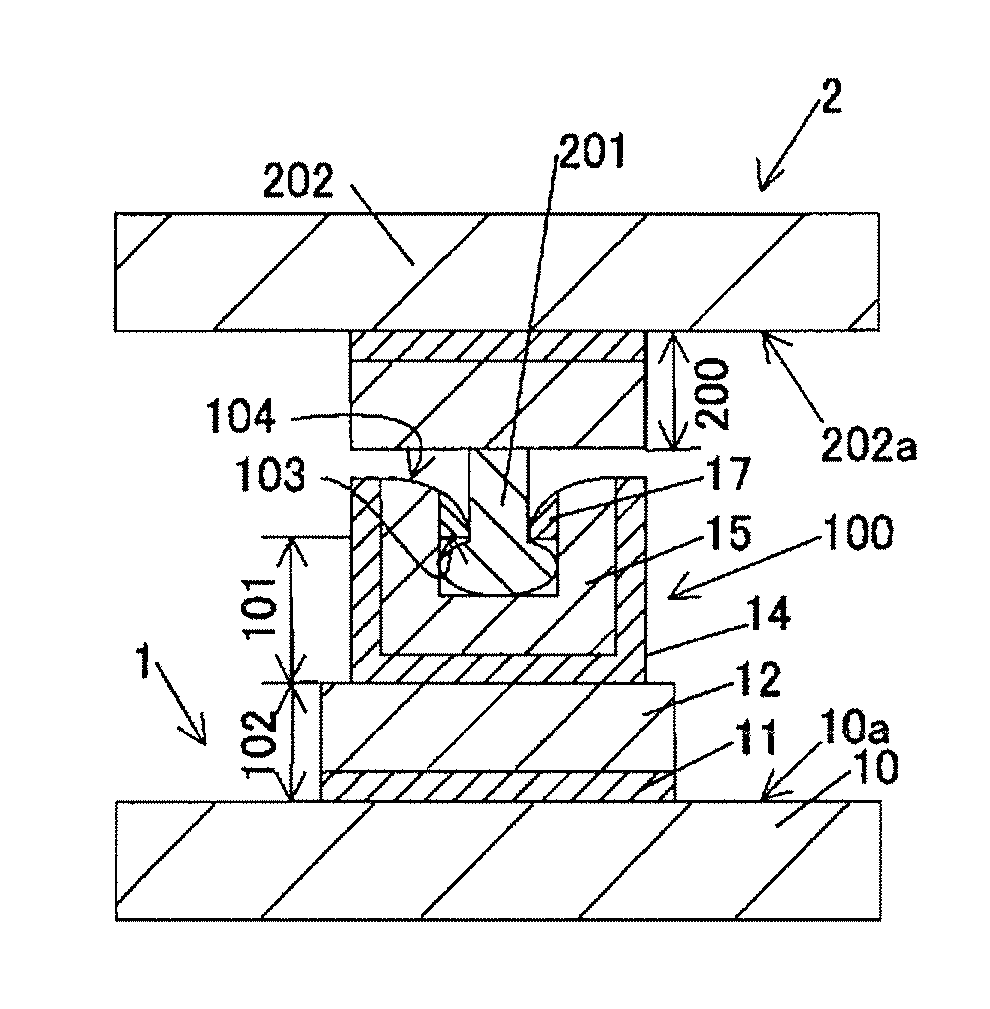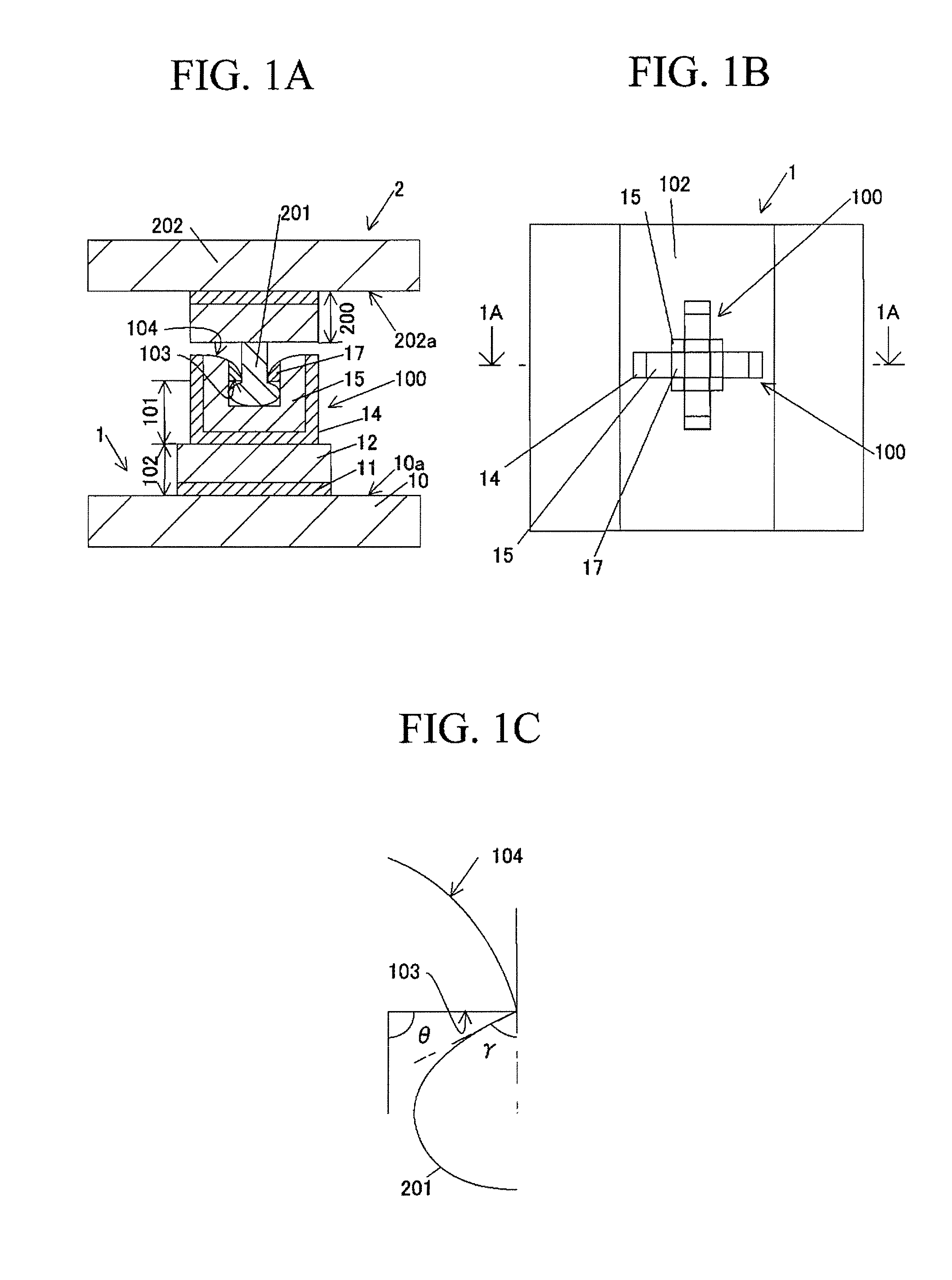Electronic component and method of forming the same
- Summary
- Abstract
- Description
- Claims
- Application Information
AI Technical Summary
Benefits of technology
Problems solved by technology
Method used
Image
Examples
first embodiment
Configurations of Electronic Components:
[0089]FIG. 1A is a cross sectional elevation view illustrating a first electronic component 1 and a second electronic component 2 that is connected to the first electronic component1 in accordance with a first preferred embodiment of the present invention. FIG. 1B is a plan view illustrating the first electronic component shown in FIG. 1A which is a view taken along a 1A-1A line of FIG. 1B.
First Electronic Component 1:
[0090]A first electronic component 1 can be configured to be connected to a second electronic component 2. In some cases, the first electronic component 1 may include, but is not limited to, a substrate 10, and a connector 100. The substrate 10 may have a bonding surface 10a that has a conductive interconnection element thereon such as a surface interconnection 102. In some cases, the surface interconnection 102 may include, but is not limited to, a multilayered structure of a seed layer 11 and a conductive film 12.
[0091]The conn...
second embodiment
Configurations of Electronic Components:
[0106]FIG. 2A is a cross sectional elevation view illustrating a third electronic component 3 and the second electronic component 2 that is connected to the third electronic component 3 in accordance with a second preferred embodiment of the present invention. FIG. 2B is a plan view illustrating the third electronic component shown in FIG. 2A which is a view taken along a 2A-2A line of FIG. 2B.
[0107]The second electronic component 2 of this embodiment is the same as the second electronic component 2 of the first embodiment. The third electronic component 3 of this embodiment is different from the first electronic component 1 of the first embodiment. The third electronic component 3 may have guiding surfaces 105 which are sloped down toward the center of the connector 100. In some cases, the guiding surfaces 105 may be sloped planes and non-curved surfaces. In particular cases, the sloped planes may have an angle of about 45 degrees. The downwa...
third embodiment
[0108]Configurations of Electronic Components:
[0109]FIG. 3A is a cross sectional elevation view illustrating a fourth electronic component 4 and a fifth electronic component 5 that is connected to the fourth electronic component 4 in accordance with a third preferred embodiment of the present invention. FIG. 3B is a plan view illustrating the third electronic component shown in FIG. 3A which is a view taken along a 3A-3A line of FIG. 3B.
Fourth Electronic Component 4:
[0110]A fourth electronic component 4 can be configured to be connected to a fifth electronic component 5. In some cases, the fourth electronic component 4 may include, but is not limited to, a substrate 10, and a connector 120. The substrate 10 may have a bonding surface 10a that has a conductive interconnection element thereon such as a surface interconnection 102. In some cases, the surface interconnection 102 may include, but is not limited to, a multilayered structure of a seed layer 11 and a conductive film 12.
[011...
PUM
| Property | Measurement | Unit |
|---|---|---|
| Electrical conductivity | aaaaa | aaaaa |
| Electrical conductor | aaaaa | aaaaa |
| Elasticity | aaaaa | aaaaa |
Abstract
Description
Claims
Application Information
 Login to View More
Login to View More - R&D Engineer
- R&D Manager
- IP Professional
- Industry Leading Data Capabilities
- Powerful AI technology
- Patent DNA Extraction
Browse by: Latest US Patents, China's latest patents, Technical Efficacy Thesaurus, Application Domain, Technology Topic, Popular Technical Reports.
© 2024 PatSnap. All rights reserved.Legal|Privacy policy|Modern Slavery Act Transparency Statement|Sitemap|About US| Contact US: help@patsnap.com










